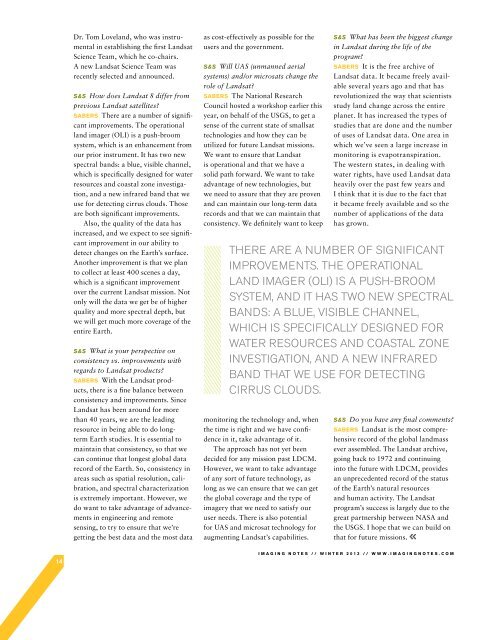download PDF - Imaging Notes
download PDF - Imaging Notes
download PDF - Imaging Notes
Create successful ePaper yourself
Turn your PDF publications into a flip-book with our unique Google optimized e-Paper software.
Dr. Tom Loveland, who was instrumental<br />
in establishing the first Landsat<br />
Science Team, which he co-chairs.<br />
A new Landsat Science Team was<br />
recently selected and announced.<br />
S&S How does Landsat 8 differ from<br />
previous Landsat satellites<br />
SABERS There are a number of significant<br />
improvements. The operational<br />
land imager (OLI) is a push-broom<br />
system, which is an enhancement from<br />
our prior instrument. It has two new<br />
spectral bands: a blue, visible channel,<br />
which is specifically designed for water<br />
resources and coastal zone investigation,<br />
and a new infrared band that we<br />
use for detecting cirrus clouds. Those<br />
are both significant improvements.<br />
Also, the quality of the data has<br />
increased, and we expect to see significant<br />
improvement in our ability to<br />
detect changes on the Earth’s surface.<br />
Another improvement is that we plan<br />
to collect at least 400 scenes a day,<br />
which is a significant improvement<br />
over the current Landsat mission. Not<br />
only will the data we get be of higher<br />
quality and more spectral depth, but<br />
we will get much more coverage of the<br />
entire Earth.<br />
S&S What is your perspective on<br />
consistency vs. improvements with<br />
regards to Landsat products<br />
SABERS With the Landsat products,<br />
there is a fine balance between<br />
consistency and improvements. Since<br />
Landsat has been around for more<br />
than 40 years, we are the leading<br />
resource in being able to do longterm<br />
Earth studies. It is essential to<br />
maintain that consistency, so that we<br />
can continue that longest global data<br />
record of the Earth. So, consistency in<br />
areas such as spatial resolution, calibration,<br />
and spectral characterization<br />
is extremely important. However, we<br />
do want to take advantage of advancements<br />
in engineering and remote<br />
sensing, to try to ensure that we’re<br />
getting the best data and the most data<br />
as cost-effectively as possible for the<br />
users and the government.<br />
S&S Will UAS (unmanned aerial<br />
systems) and/or microsats change the<br />
role of Landsat<br />
SABERS The National Research<br />
Council hosted a workshop earlier this<br />
year, on behalf of the USGS, to get a<br />
sense of the current state of smallsat<br />
technologies and how they can be<br />
utilized for future Landsat missions.<br />
We want to ensure that Landsat<br />
is operational and that we have a<br />
solid path forward. We want to take<br />
advantage of new technologies, but<br />
we need to assure that they are proven<br />
and can maintain our long-term data<br />
records and that we can maintain that<br />
consistency. We definitely want to keep<br />
monitoring the technology and, when<br />
the time is right and we have confidence<br />
in it, take advantage of it.<br />
The approach has not yet been<br />
decided for any mission past LDCM.<br />
However, we want to take advantage<br />
of any sort of future technology, as<br />
long as we can ensure that we can get<br />
the global coverage and the type of<br />
imagery that we need to satisfy our<br />
user needs. There is also potential<br />
for UAS and microsat technology for<br />
augmenting Landsat’s capabilities.<br />
S&S What has been the biggest change<br />
in Landsat during the life of the<br />
program<br />
SABERS It is the free archive of<br />
Landsat data. It became freely available<br />
several years ago and that has<br />
revolutionized the way that scientists<br />
study land change across the entire<br />
planet. It has increased the types of<br />
studies that are done and the number<br />
of uses of Landsat data. One area in<br />
which we’ve seen a large increase in<br />
monitoring is evapotranspiration.<br />
The western states, in dealing with<br />
water rights, have used Landsat data<br />
heavily over the past few years and<br />
I think that it is due to the fact that<br />
it became freely available and so the<br />
number of applications of the data<br />
has grown.<br />
THERE ARE A NUMBER OF SIGNIFICANT<br />
IMPROVEMENTS. THE OPERATIONAL<br />
LAND IMAGER (OLI) IS A PUSH-BROOM<br />
SYSTEM, AND IT HAS TWO NEW SPECTRAL<br />
BANDS: A BLUE, VISIBLE CHANNEL,<br />
WHICH IS SPECIFICALLY DESIGNED FOR<br />
WATER RESOURCES AND COASTAL ZONE<br />
INVESTIGATION, AND A NEW INFRARED<br />
BAND THAT WE USE FOR DETECTING<br />
CIRRUS CLOUDS.<br />
S&S Do you have any final comments<br />
SABERS Landsat is the most comprehensive<br />
record of the global landmass<br />
ever assembled. The Landsat archive,<br />
going back to 1972 and continuing<br />
into the future with LDCM, provides<br />
an unprecedented record of the status<br />
of the Earth’s natural resources<br />
and human activity. The Landsat<br />
program’s success is largely due to the<br />
great partnership between NASA and<br />
the USGS. I hope that we can build on<br />
that for future missions.<br />
14<br />
IMAGING NOTES // WINTER 2013 // WWW.IMAGINGNOTES.COM











